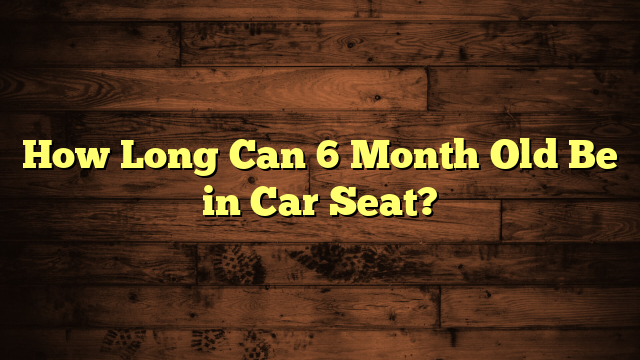Can a 6 Year Old Use a Booster Seat?
When considering safety, comfort, and legal requirements, you might wonder if a 6-year-old should use a booster seat. While many parents move their children to regular seat belts at this age, it is crucial to understand the specific weight and height criteria that dictate the appropriate use of booster seats. You may think your child is ready for a seat belt, but is it truly safe? Exploring the nuances of booster seat regulations can shed light on the best practices for ensuring your child's safety during car rides.
Key Takeaways
- A 6-year-old can use a booster seat if they weigh between 40-100 pounds and are at least 4 years old.
- Proper seat belt fit is crucial; the lap belt should be snug across the thighs, not the stomach.
- Many states require booster seats for children up to age eight or until they reach 80 pounds.
- Ensure the booster seat is properly installed according to the manufacturer's instructions for maximum safety.
- Regularly check for recalls and safety certifications from NHTSA to ensure the booster seat's reliability.
Understanding Booster Seat Requirements
When it comes to keeping your child safe in the car, understanding booster seat requirements is vital. Booster seat regulations vary by state, but they all aim to enhance child safety. Generally, these laws mandate that children who outgrow their forward-facing car seats should use a booster seat until they reach a certain height or weight. This guarantees that the vehicle's seat belt fits properly, providing ideal protection during a crash.
You should check your local child safety laws to verify compliance. Many states require booster seats for children up to age eight or until they weigh at least 80 pounds. Remember, using a booster seat helps position the seat belt correctly across your child's shoulder and lap, minimizing the risk of injury.
It's important to install the booster seat according to the manufacturer's instructions. Also, it's a good idea to have your child practice buckling the seat belt themselves.
Age and Weight Considerations
Understanding the specific age and weight guidelines for booster seats is essential to ensuring your child's safety in the car. When considering whether your 6-year-old can use a booster seat, you'll want to look at their weight and developmental milestones. Most booster seats are designed for children who weigh between 40 and 100 pounds and are at least 4 years old.
At 6 years old, your child might be ready for a booster seat, but it's important to check their weight. A properly fitting seatbelt is vital for safety; it should lie flat across the upper thighs and be snug across the shoulder, not touching the neck or face.
If your child hasn't yet reached the required weight or height, it's best to keep them in a forward-facing car seat with a harness until they do.
Remember, every child develops differently, so don't rush the change based solely on age. Always prioritize their comfort and safety, ensuring they meet both age and weight requirements before making the switch.
Safety Standards and Guidelines
To guarantee your child's safety while using a booster seat, it's important to adhere to established safety standards and guidelines. These regulations help make certain that booster seats provide the maximum protection for your little one during car rides. Knowing the specific safety regulations and certifications can make all the difference.
Here are some key points to keep in mind:
- Look for certifications: Always check for labels indicating compliance with safety regulations set by organizations like the National Highway Traffic Safety Administration (NHTSA).
- Select the right size: Booster seats should match your child's weight and height for the best safety.
- Follow installation instructions: Proper installation is vital; read the manual and confirm it's securely fastened.
- Use the seat belt correctly: Make sure the lap and shoulder belts fit snugly over your child when using the booster seat.
- Regularly check for recalls: Stay informed about any recalls on booster seats to maintain continued safety.
Benefits of Using a Booster Seat
Using a booster seat offers numerous advantages that enhance your child's safety during car rides. One of the primary benefits is boosted safety, as these seats elevate your child to a proper height. This positioning guarantees that seat belts fit correctly across the lap and shoulder, reducing the risk of injury in case of an accident.
Additionally, a booster seat provides comfort enhancement for your little one. With padded seats and armrests, your child can enjoy longer journeys without discomfort, making car rides more pleasant for everyone.
Here's a quick overview of the benefits:
| Benefit | Description | Impact on Child |
|---|---|---|
| Boosted Safety | Proper seat belt positioning | Reduced injury risk |
| Comfort Enhancement | Padded seats and adjustable features | Increased comfort |
| Improved Visibility | Elevated height provides better views | Less car sickness |
| Independence | Encourages self-buckling with seat belts | Boosts confidence |
Transitioning From Car Seat to Booster
Shifting your child from a car seat to a booster seat is an important milestone in their development. This car seat change can be exciting yet intimidating, as you want to guarantee your child's safety while adapting to new booster seat types.
Here are some key points to reflect on during this change:
- Age and Size: Check your child's age, weight, and height to determine if they're ready for a booster.
- Booster Seat Types: Familiarize yourself with various booster seat types, including high-back and backless options, and choose one that fits your vehicle.
- Installation: Make sure the booster seat is installed correctly and securely to maximize safety.
- Seat Belt Use: Teach your child how to use the vehicle's seat belt properly with the booster seat.
- Monitoring: Keep an eye on your child's comfort and safety during rides, adjusting the booster seat as needed.
Common Misconceptions About Booster Seats
You might think that booster seats are only about age, but that's a common misconception.
Height and weight play vital roles in determining when your child is ready to shift. Understanding these factors can help guarantee your child stays safe and secure while riding in the car.
Age Requirements Misunderstood
Many parents tend to overlook the age requirements for booster seats, leading to common misconceptions that can put kids at risk.
It's essential to understand that age alone isn't a definitive measure for using a booster seat. Here are some common age misconceptions and safety myths:
- All kids over 6 don't need a booster: Many believe once kids hit 6, they can sit without one, but it depends on their size.
- Boosters are only for toddlers: Some think boosters are outdated, but they're vital for older kids too.
- Seat belts are enough for older kids: While seat belts are important, they don't fit young children properly without a booster.
- All states have the same laws: Misunderstandings arise because each state has different booster seat laws that vary by age and weight.
- Once a child is in a booster, they're safe: It's not just about being in a booster; it's about using it correctly.
Height and Weight Factors
Some parents mistakenly believe that height and weight are secondary considerations when it comes to using booster seats. In reality, these factors are essential for guaranteeing your child's safety during car rides. Most booster seats come with specific height requirements and weight limits that you shouldn't ignore.
Generally, children should use a booster seat until they reach a height of about 4 feet 9 inches and weigh between 80 to 100 pounds. These guidelines guarantee that the car's seatbelt fits properly across your child's body, offering maximum protection in the event of an accident.
If your child exceeds the height or weight limits of their booster seat, it's time to shift them to a regular seatbelt. Ignoring these height and weight factors can lead to improper seatbelt positioning, which greatly increases the risk of injury.
So, take the time to measure your child and review the booster seat specifications. Remember, following these guidelines isn't just about compliance; it's about keeping your child safe on the road.
Prioritizing height and weight considerations will give you peace of mind and protect your little one during every car trip.
Frequently Asked Questions
Can a Child Use a Booster Seat Without a Backrest?
Yes, a child can use a backless booster, but you should guarantee it meets booster seat safety guidelines. Make sure the seatbelt fits correctly, providing the necessary support and protection for your child while traveling.
How Do I Determine if My Booster Seat Is Expired?
Check your booster seat's lifespan by examining its expiration date, usually on a label. Adhere to safety regulations; if it's over six years old, it's time to toss it for your child's protection.
Can Booster Seats Be Used in the Front Seat?
You should check local booster seat regulations, as laws vary. Generally, for front seat safety, it's safer to keep children in the back until they're at least 13, ensuring proper use of booster seats.
Are There Height Requirements for Using a Booster Seat?
Imagine your child growing like a tree, needing support until they're strong enough to stand tall. Booster seat laws vary, but generally, kids need to reach a minimum height for compliance with child safety regulations.
What if My Child Falls Asleep in a Booster Seat?
If your child falls asleep in a booster seat, make certain they're in proper positioning for sleep safety. Check the seat's harness and adjust it to keep them secure while they rest comfortably during travels.
Conclusion
To sum up, using a booster seat for your 6-year-old isn't just about meeting requirements; it's about ensuring their safety on the road. Think of it like a sturdy bridge that supports a traveler across a rushing river—without it, the journey can be perilous. By investing in a booster seat, you're not only following guidelines but also protecting your child from potential harm. So buckle up, and let's make every car ride a safe adventure!
- Can I Get in a Taxi Without a Car Seat? - January 26, 2025
- Can I Get Chlamydia From a Toilet Seat? - January 26, 2025
- Can I Get an Uber With a Car Seat? - January 26, 2025






